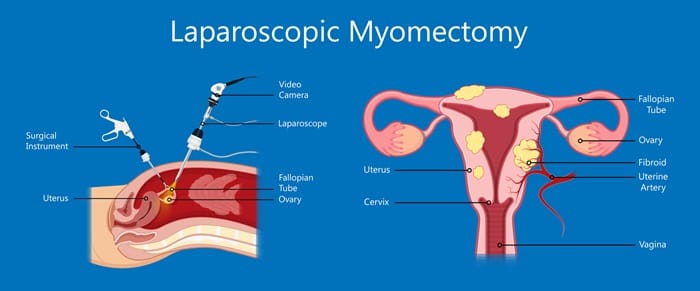If you are searching for a skilled surgeon with a lot of experience in laparoscopic fibroid removal/removal of fibroid without big cuts on your tummy, this article is for you.
Senior gynecologist in Jaipur Dr. Pankhuri Gautam has performed more than 2000 laparoscopic fibroid removal surgery/myomectomy, which include fibroids weighing more than 2.5 – 3 kg in unmarried and young girls. The success of laparoscopic myomectomy depends on the skill set of the surgeon and the meticulous suturing of the remaining uterus once the fibroid has been removed.
Myomectomy (Myoma = fibroids, ectomy = removal) means surgical removal of fibroids. This is the procedure of choice for women who have symptomatic fibroids and do not wish to have a hysterectomy (surgical removal of the uterus and, most likely, the cervix). Myomectomy can be performed either by keyhole approach (laparoscopically) or by open abdominal approach (by making a larger surgical incision on the abdomen).
Laparoscopic myomectomy offers many advantages compared to open abdominal surgery, such as:
- Enhanced recovery,
- Short hospital stay,
- Cosmetically improved scar,
- Reduced adhesions (scarring) from the procedure,
- Comparable pregnancy rates.
Laparoscopic myomectomy is an advanced laparoscopic procedure, and its success depends very much on the experience and expertise of the surgeon.
Is Laparoscopic Myomectomy Suitable For All Fibroids?
Myomectomy can be performed as a hysteroscopic, open, or laparoscopic procedure.
- Hysteroscopic Myomectomy:
Submucous (indenting on the uterus cavity) fibroids less than 4cm in size and a safe distance away from the outer border of the uterus can be resected through a trans-cervical approach. In this day surgery procedure, a telescope is inserted through the neck of the womb (cervix), and this route removes the fibroid. There are no incisions involved, and the recovery is rapid.
- Laparoscopic myomectomy:
In today’s era of enhanced technology and the hard work of surgeons, it is possible to remove fibroids of any shape and size by a doorbeen/Endoscope/laparoscope. Conventionally, this procedure is considered when the largest fibroid is less than 10cm, and the total number of fibroids is less than 5.
- Open Myomectomy:
A bikini-line incision is generally used, but a midline incision is occasionally required.
However, to her credit, Dr Pankhuri Gautam has removed all fibroids through a laparoscope, and no surgery has needed any conversion to open surgery in the last 5 years. However, the team is always prepared in case of a change of plan from laparoscopic to open surgery whenever deemed for the safety of patient health.
Generally, the estimated duration of surgery is expected to be less than two hours when a laparoscopic approach is used.
Advantages of Opting for Laparoscopic Myomectomy for Fibroid Removal
Laparoscopic myomectomy, a minimally invasive surgical procedure, offers several benefits for removing fibroids:
- It involves making tiny incisions in the abdomen instead of a large cut. This results in more minor scars, less pain, and quicker recovery than traditional open surgery.
- Laparoscopic myomectomy allows the surgeon to remove fibroids while preserving the uterus. This is especially beneficial for women who wish to maintain their fertility or keep their uterus intact.
- The procedure typically causes less blood loss during surgery, lowering the chances of needing blood transfusions.
- Patients often experience a faster recovery time with laparoscopic myomectomy. They may return to regular activities sooner compared to open surgery.
- Due to the smaller incisions and minimized tissue trauma, there’s a reduced risk of infection, hernias, and other surgical complications.
- The smaller scars from the tiny incisions typically heal and fade over time, offering a more cosmetically appealing outcome.
- Patients often report experiencing less postoperative pain and discomfort after laparoscopic myomectomy compared to open surgery.
How Are The Fibroids Removed Through Such Small Incisions?
A special morcellator device cuts the fibroid into smaller pieces and then extracts it through a smaller incision.
What Incisions Are Made?
Generally, 3 or 4 small nicks are made on the abdomen depending on the uterine size and other circumstances. One 12mm incision was completed within the umbilicus; the remaining incisions are smaller (5mm).
What Preoperative Investigations Are Required for Laparoscopic Myomectomy?
A consultation involving full history, assessment of symptoms, and clinical examination are necessary, along with an ultrasound scan. This scan will delineate the number, size, and location of fibroids. Occasionally, an MRI scan may be required especially if adenomyosis is suspected. (Adenomyosis is a condition where the uterus is enlarged due to infiltration of the uterine lining into the muscle layer. It leads to heavy and painful periods and sometimes can be mistaken for a fibroid uterus).
What About Preoperative Medical Treatment To Shrink Fibrosis?
GnRH analogs can be administered as a monthly or three-monthly intramuscular injection. This therapy might/might not lead to shrinkage in the size of fibroids; however, keeping in mind the risks of weakening of bone and other side effects of this therapy, fibroids larger than 5 cm causing symptoms should be dealt with minimally invasive laparoscopic surgery or hysteroscopic myomectomy.
What Precautions Are Taken To Reduce Blood Loss During Surgery?
The pressure of gas used during laparoscopy reduces the amount of bleeding. An anti-diuretic hormone diluted in 100ml of saline is injected into the fibroids capsule. This causes spasms of blood vessels and reduced bleeding. A harmonic scalpel is used, which, in addition to incising, also seals the blood vessels simultaneously. Planning and speed of surgery are essential to minimize bleeding from the procedure.
Is There A Risk Of Blood Transfusion Or A Hysterectomy?
Uterine fibroids have a large blood supply and are, therefore, prone to bleeding during removal. With precautions as mentioned above, bleeding is not a big problem, and blood transfusion is rarely required (less than 10% chance with laparoscopic myomectomy). With meticulous planning, pragmatic decision-making, and judicious use of blood transfusion, a hysterectomy is rarely necessary as a result of intra-operative bleeding.
How Are Adhesions Prevented?
With the laparoscopic approach, minimal tissue handling reduces the risk of adhesions. Saline irrigation is also constantly in use, preventing tissue drying and blood clots from sticking to the tissues. Meticulous control of bleeding also is essential. Finally, an adhesion prevention barrier such as Adept Solution or Interceed is used at the end of the procedure.
What About Future Pregnancy And Risk Of Uterine Rupture?
Laparoscopic myomectomy is a safe procedure from this point of view. Your surgeon will be able to advise you if an elective (planned) Caesarean Section is indicated or if you will be able to have a normal delivery.
What About Recovery from Laparoscopic Myomectomy?
Depending on how well you recover, you will stay in the hospital for 24-48 hours. You may be uncomfortable, especially when moving, but this will be well-controlled with analgesia. You may have light vaginal bleeding and some shoulder pain. You will feel tired but can eat and drink normally, walk around, and go to the toilet. You will be discharged from the hospital after 24-48 hours.
For the first three days after discharge, we recommend taking regular painkillers. You could take short walks, wash and shower as usual, and avoid lifting heavy loads. You should also get plenty of rest (8 hours at night, two hours during the day). You will be seen at the end of the first week for a post-operative review and suture removal. You should gradually increase activity levels and be able to return to work by four weeks. The key to enjoying your recovery period lies in planning. So get all the DVDs you want to watch and the books you have always wanted to read, and the four weeks will pass quickly.
Conclusion
Opting for laparoscopic myomectomy to remove fibroids offers numerous advantages that can significantly improve the surgical experience and recovery for individuals dealing with these growths.
The benefits of smaller incisions, preservation of the uterus, reduced blood loss, quicker recovery, and lower risks of complications make laparoscopic myomectomy a beneficial choice for many seeking fibroid removal.
If you’re considering this procedure or want more personalised guidance on fibroid treatment options, connecting with a specialist like Dr Pankhuri Gautam, an expert laparoscopic surgeon in Jaipur, can provide valuable insights and tailored advice. Dr Pankhuri Gautam’s expertise can offer clarity and support in making informed decisions about managing fibroids and choosing the most suitable treatment approach for your needs.
Connect with the expert now to know more!






